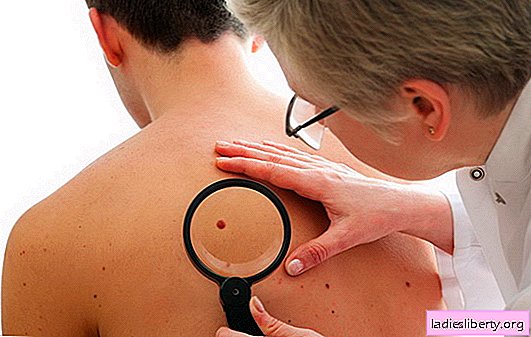
The attitude to moles in people is ambiguous.
For some, a mole means God's mark, and for someone, an original speck gives originality and special charm.
But those people who were lucky enough to become the owner of unusual and dangerous moles, as well as located in uncomfortable places, have to look for effective ways to get rid of moles.
Moles: causes and types
From a physiological point of view, a mole is not just a skin defect, but a real benign tumor. However, most moles do not pose a threat to human health. The question of the removal of moles may arise when certain inconveniences associated with:
1. Discomfort provoked by moles that undergo friction or abrasion.
2. The aesthetic appearance of moles, especially hanging, loose and pigmented.
3. Unnatural growth of moles.
The number of moles on the body increases with age. Congenital nevus is a fairly rare occurrence. The appearance of moles is affected by a genetic predisposition. A child whose parents have a large number of moles is predisposed to their appearance.
Throughout life, the number and appearance of spots on the body is constantly changing. Moles can appear anywhere on the body. In addition, they are able to become convex, as well as change their shade and shape.
The formation of nevi can be affected by:
1. Endocrine changes in the body, which explains the abundant appearance of moles during the transitional age, as well as during pregnancy.
2. Dermatological pathologies in the form of rashes, irritations and acne, which provokes the appearance of inflammatory changes in the epidermis.
3. Long-term exposure to sunlight on the skin. Sun exposure is not recommended for people predisposed to the appearance and growth of nevi.
Doctors recommend watching the change in the number and even more so the condition of moles. With unnatural changes, it is advisable to visit a dermatologist.
Questions related to the removal of moles arise quite often. But the process itself to eliminate such defects will depend on the type of mole. There are some types of formations in which it is quite dangerous to engage in independent breeding of moles.
Mole classification depends on the physiological characteristics of education. The main common types of nevi can be distinguished:
1. Purchased. The most common education that appears during life does not cause any discomfort and does not carry a threat. Such nevi in medicine are referred to as the common mole.
2. Atypical. These nevi are dysplastic. They differ in suspicious sizes, as well as color. Sometimes they reach quite large sizes and can have a rather strange shape. If such a formation is found, urgent consultation is required, since such moles quite often degenerate into melanoma.
3. Birthmarks. These formations are congenital. One out of a hundred people is born with such marks. Such spots have a different shade, and their size can vary from scanty and barely noticeable to just huge. Doctors warn that the likelihood of skin cancer in people with large congenital birthmarks is quite high.
4. Epitolioid. These are rare unusual formations of pink color, having a rounded shape and protruding above the surface of the skin. They are quite similar to melanoma. In addition, these nevi often bleed, itch and emit a specific smell.
How to get rid of moles: medicines
The ideal option for removing moles is medical or cosmetic care. Moreover, modern technology allows this process to be made quite painless and does not leave postoperative scars. However, if you decide to do the birth of moles yourself, it is advisable to play it safe and consult a dermatologist about the quality of the mole that needs to be removed.
To remove a mole, you can try using a solution of weak acids. These substances are specially created for such procedures. Acidic solutions can be obtained without a prescription in a pharmacy.
Handle such products very carefully and accurately comply with the requirements set forth in the instructions. With careless handling of the solution, there is a high probability of damage to healthy skin located directly next to the mole. For the application of acid solutions, special devices are used that are available with the medicine. Acidic preparations are available as liquid solutions, plasters, creams, lotions and tampons.
Often, salicylic acid is used to get rid of moles.
Acid methods sometimes help completely get rid of an unwanted mole. However, some patients can only reduce the size of an unnatural formation.
Dermatologists advise using BIO T at home to remove moles. In fact, this is a drug consisting of collecting medicinal herbs with mineral salts, which helps to cope with moles and other skin defects.
Such a tool must be applied to the mole itself, avoiding adjacent areas. A bandage is applied to the treated formation. The action of the drug begins instantly. You can get rid of a mole in this way in just 5 days.
How to get rid of a mole: folk recipes
Traditional healers offer methods that can either completely eliminate the mole, or lighten the formation, which makes it less noticeable.
Garlic
Garlic contains specific enzymes that can actually dissolve a mole. This effect is explained by the splitting of the accumulation of cells that form an unnatural spot.
To remove the mole, you need to apply a thin slice of fresh garlic to it twice a day. To completely remove the mole, the procedure is repeated for up to seven days.
As a therapeutic agent, garlic paste is also used, which is prepared by grinding on a grater or in a combine. Such a paste must be applied to a mole under a bandage overnight. Repeat garlic sessions for a week.
Juices
Juice therapy helps to cope with the problem of unnatural moles. For these purposes, juices that contain acidic as well as astringent components are suitable. Such substances act on the cells, corroding them. As a result of treatment, the mole may dry out and completely disappear.
1. Apple juice is used three times a day to remove moles. For a full course of treatment, it may be necessary to repeat the procedure for three weeks.
2. Onion juice lubricated mole up to 4 times a day and kept for up to 40 minutes. After which the juice should be wiped with a wet swab.
3. Pineapple juice is applied overnight. Pineapple slices can also be applied to the mole.
4. A mixture of pomegranate juice with lime juice is applied to the mole also at night. At the same time, the pulp should be fixed with a bandage on top. In the morning, the mixture is washed off.
Soda
You can prepare a therapeutic ointment, which will include soda and a few drops of castor oil. The ointment is thoroughly mixed until a homogeneous paste is obtained. Apply this ointment under a bandage for the whole night. Repeat treatment sessions is necessary until the nevus is completely eliminated, which may require up to 10 procedures.
How to get rid of moles in a small child?
The presence of congenital moles in a baby is not a reason for unnecessary anxiety. However, if the nevus has an unnatural appearance or interferes with the child, it is often amenable to stripping, combing and rubbing, you will have to get rid of such a mole.
It is dangerous to independently engage in the removal of moles in a child. Children's skin is more delicate and more likely when exposed to pharmacy or folk caustic substances damage and the appearance of additional dermatological problems.
In addition, when removing moles in young children, there is a risk of colloidal scars in adolescence. Therefore, to remove moles in babies they resort only for medical reasons and in a clinic.
Do not get rid of dangerous, unnatural, bleeding, inflamed moles. Nevertheless, nevus is a tumor, albeit benign. Therefore, entrust this problem to professionals.











